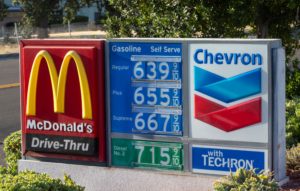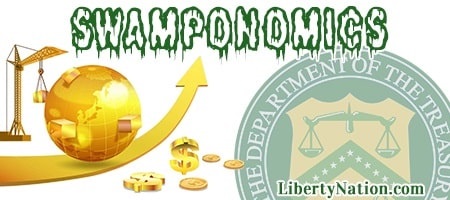Diesel prices are soaring, and Old Man Winter has yet to make his triumphant return. The national average price for a gallon of diesel has climbed all the way back above $5.21, according to the American Automobile Association (AAA). This is up more than 6% from just a week ago. But while the pain at the pump is returning for typical motorists, the spread between gasoline and diesel prices – $1.31 – should be noted since it is a record. Since freezing temperatures and heavy snowfall have yet to blanket the United States, what’s happening, exactly?
What’s the Deal with Diesel Prices?
 The first problem is on the supply front. The latest Energy Information Administration (EIA) data show that distillate inventories plunged 4.853 million barrels and distillate fuel output fell 325,000 barrels for the week ending Oct. 7. Domestic stockpiles have fallen for three consecutive weeks, totaling more than 11 million barrels. The latest price movements are concerning with home heating demand (HHD) expected to trend higher in the coming months.
The first problem is on the supply front. The latest Energy Information Administration (EIA) data show that distillate inventories plunged 4.853 million barrels and distillate fuel output fell 325,000 barrels for the week ending Oct. 7. Domestic stockpiles have fallen for three consecutive weeks, totaling more than 11 million barrels. The latest price movements are concerning with home heating demand (HHD) expected to trend higher in the coming months.
The second contributing factor is the current situation with US refineries. There have been widespread refinery outages on the west coast and in the Midwest. Several refineries are undergoing routine maintenance in other parts of the country. And, in the last week, refiners are reportedly preparing for the possibility that President Joe Biden would institute some type of fuel export ban ahead of the midterm elections in November. The energy industry has opposed the White House’s proposal, arguing that it would slash output and result in higher long-term prices.
Lastly, this is also a fundamental challenge for the sector because of the current administration’s significant dose of regulations on heavy fuel, making it more difficult for refiners to sustain operations and run at maximum capacity.

(Photo by George Rose/Getty Images)
Perhaps the United States will get lucky and not suffer from severe outages of diesel. However, households will not be lucky on their utility bills, as the EIA’s Winter Fuels Outlook published on Oct. 13 warned that a colder-than-average winter forecast and higher energy prices will trigger soaring heating costs, from natural gas to heating oil to electricity. The only upside is that at least the US is not Europe.
Dollar King Reigns Supreme
When inflation is running north of 8%, the Federal Reserve has printed 40% of all US dollars ever created in more than two years, and its status as an international reserve currency has eroded, how can the US Dollar Index (DXY) soar to its highest level in 20 years? The DXY, which measures the greenback against a basket of currencies, advanced 0.83% to 113.30 to settle the Oct. 14 trading session. It posted a 0.45% weekly gain and added to its year-to-date rally of more than 18%.
Indeed, a strong buck has been one of the developments in this upside-down economy. But this is what happens when foreign investors are purchasing dollar-denominated assets for higher yields, brighter outlooks, and safety, which then weighs on local currency markets. Of course, the Eccles Building’s quantitative tightening (QT) has contributed to the greenback’s meteoric ascent, resulting in sky-high borrowing costs and a collapse in the dollar-denominated commodities market. The Fed is beginning to panic since this is the last thing the institution desires. For reasons yet to be confirmed – perhaps to avert a global emergency funding crunch – the central bank shipped over a record $6.3 billion to the Swiss National Bank (SNB) through a swap line for the second time this year.
A strengthening dollar would typically add to consumers’ purchasing power in another kind of economic landscape. But since inflation is everywhere, this is no longer the case. In fact, only damage could be done now, as Bob Michele, the chief investment officer of J.P. Morgan Asset Management, told Bloomberg: “When the central bank steps on the brakes, something goes through the windshield.”
 Feelin’ Fine?
Feelin’ Fine?
The preliminary University of Michigan’s October readings of consumer sentiment were mixed. The Consumer Sentiment Index climbed to 59.8, topping market estimates of 59. Current Economic Conditions also surged to 65.3, higher than economists’ projections of 59.9. But then look at this odd development: Consumer Expectations fell to 56.2, falling short of the consensus of 58.5. In addition, one- and five-year inflation forecasts rose to 5.1% and 2.9%, respectively.
“Continued uncertainty over the future trajectory of prices, economies, and financial markets around the world indicate a bumpy road ahead for consumers,” said Surveys of Consumers Director Joanne Hsu in a statement.
This is a complete reversal from just a few months ago when consumers were all doom and gloom about the current state of the economy but optimistic about the future. Indeed, conditions are a lot worse right now. Americans are getting poorer because of rampant price inflation, winter is coming (see above), higher interest rates are making borrowing more expensive, and the baseball season is nearly over. Perhaps understanding how a consumer’s mind works rests with this question: How much worse can it possibly get?

